


 تاريخ الرياضيات
تاريخ الرياضيات
 الرياضيات في الحضارات المختلفة
الرياضيات في الحضارات المختلفة 
 الرياضيات المتقطعة
الرياضيات المتقطعة
 الجبر
الجبر
 الهندسة
الهندسة 
 المعادلات التفاضلية و التكاملية
المعادلات التفاضلية و التكاملية 
 التحليل
التحليل
 علماء الرياضيات
علماء الرياضيات |
Read More
Date: 9-6-2019
Date: 26-9-2019
Date: 31-8-2019
|
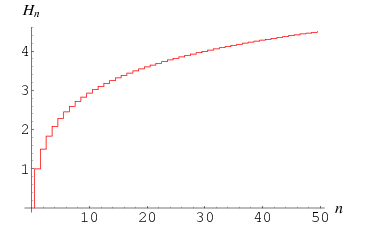
A harmonic number is a number of the form
 |
(1) |
arising from truncation of the harmonic series. A harmonic number can be expressed analytically as
 |
(2) |
where  is the Euler-Mascheroni constant and
is the Euler-Mascheroni constant and  is the digamma function.
is the digamma function.
The first few harmonic numbers  are 1,
are 1,  ,
,  ,
,  ,
,  , ... (OEIS A001008 and A002805). The numbers of digits in the numerator of
, ... (OEIS A001008 and A002805). The numbers of digits in the numerator of  for
for  , 1, ... are 1, 4, 41, 434, 4346, 43451, 434111, 4342303, 43428680, ... (OEIS A114467), with the corresponding number of digits in the denominator given by 1, 4, 40, 433, 4345, 43450, 434110, 4342302, 43428678, ... (OEIS A114468). These digits converge to what appears to be the decimal digits of
, 1, ... are 1, 4, 41, 434, 4346, 43451, 434111, 4342303, 43428680, ... (OEIS A114467), with the corresponding number of digits in the denominator given by 1, 4, 40, 433, 4345, 43450, 434110, 4342302, 43428678, ... (OEIS A114468). These digits converge to what appears to be the decimal digits of  (OEIS A002285).
(OEIS A002285).
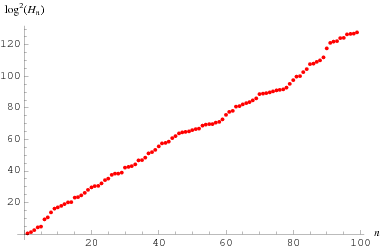
The first few indices  such that the numerator of
such that the numerator of  is prime are given by 2, 3, 5, 8, 9, 21, 26, 41, 56, 62, 69, ... (OEIS A056903). The search for prime numerators has been completed up to
is prime are given by 2, 3, 5, 8, 9, 21, 26, 41, 56, 62, 69, ... (OEIS A056903). The search for prime numerators has been completed up to  by E. W. Weisstein (May 13, 2009), and the following table summarizes the largest known values.
by E. W. Weisstein (May 13, 2009), and the following table summarizes the largest known values.
 |
decimal digits | discoverer |
| 63942 | 27795 | E. W. Weisstein (Feb. 14, 2007) |
| 69294 | 30067 | E. W. Weisstein (Feb. 1, 2008) |
| 69927 | 30301 | E. W. Weisstein (Mar. 11, 2008) |
| 77449 | 33616 | E. W. Weisstein (Apr. 4, 2009) |
| 78128 | 33928 | E. W. Weisstein (Apr. 9, 2009) |
| 78993 | 34296 | E. W. Weisstein (Apr. 17, 2009) |
| 81658 | 35479 | E. W. Weisstein (May. 12, 2009) |
The denominators of  appear never to be prime except for the case
appear never to be prime except for the case  . Furthermore, the denominator is never a prime power (except for this case) since the denominator is always divisible by the largest power of 2 less than or equal to
. Furthermore, the denominator is never a prime power (except for this case) since the denominator is always divisible by the largest power of 2 less than or equal to  , and also by any prime
, and also by any prime  with
with  .
.
The harmonic numbers are implemented as HarmonicNumber[n].
The values of  such that
such that  equals or exceeds 1, 2, 3, ... are given by 1, 4, 11, 31, 83, 227, 616, 1674, ... (OEIS A004080). Another interesting sequence is the number of terms in the simple continued fraction of
equals or exceeds 1, 2, 3, ... are given by 1, 4, 11, 31, 83, 227, 616, 1674, ... (OEIS A004080). Another interesting sequence is the number of terms in the simple continued fraction of  for
for  , 1, 2, ..., given by 1, 8, 68, 834, 8356, 84548, 841817, 8425934, 84277586, ... (OEIS A091590), which is conjectured to approach
, 1, 2, ..., given by 1, 8, 68, 834, 8356, 84548, 841817, 8425934, 84277586, ... (OEIS A091590), which is conjectured to approach  (OEIS A089729).
(OEIS A089729).

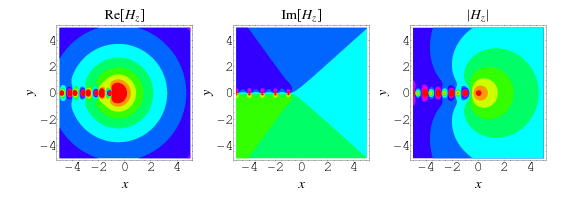
The definition of harmonic numbers can also be extended to the complex plane, as illustrated above.
Based on their definition, harmonic numbers satisfy the obvious recurrence equation
 |
(3) |
with  .
.
The number formed by taking alternate signs in the sum also has an explicit analytic form
 |
 |
 |
(4) |
 |
 |
![ln2+1/2(-1)^n[psi_0(1/2n+1/2)-psi_0(1/2n+1)]](http://mathworld.wolfram.com/images/equations/HarmonicNumber/Inline31.gif) |
(5) |
 |
 |
![ln2+1/2(-1)^n[H_((n-1)/2)-H_(n/2)].](http://mathworld.wolfram.com/images/equations/HarmonicNumber/Inline34.gif) |
(6) |
 has the particularly beautiful form
has the particularly beautiful form
 |
 |
 |
(7) |
 |
 |
 |
(8) |
 |
 |
 |
(9) |
 |
 |
 |
(10) |
 |
 |
 |
(11) |
 |
 |
 |
(12) |
The harmonic number  is never an integer except for
is never an integer except for  , which can be proved by using the strong triangle inequality to show that the 2-adic value of
, which can be proved by using the strong triangle inequality to show that the 2-adic value of  is greater than 1 for
is greater than 1 for  . This result was proved in 1915 by Taeisinger, and the more general results that any number of consecutive terms not necessarily starting with 1 never sum to an integer was proved by Kűrschák in 1918 (Hoffman 1998, p. 157).
. This result was proved in 1915 by Taeisinger, and the more general results that any number of consecutive terms not necessarily starting with 1 never sum to an integer was proved by Kűrschák in 1918 (Hoffman 1998, p. 157).
The harmonic numbers have odd numerators and even denominators. The  th harmonic number is given asymptotically by
th harmonic number is given asymptotically by
 |
(13) |
where  is the Euler-Mascheroni constant (Conway and Guy 1996; Havil 2003, pp. 79 and 89), where the general
is the Euler-Mascheroni constant (Conway and Guy 1996; Havil 2003, pp. 79 and 89), where the general  th term is
th term is  , giving
, giving  , 120,
, 120,  , 240, ... for
, 240, ... for  , 2, ... (OEIS A006953). This formula is a special case of an Euler-Maclaurin integration formulas (Havil 2003, p. 79).
, 2, ... (OEIS A006953). This formula is a special case of an Euler-Maclaurin integration formulas (Havil 2003, p. 79).

Inequalities bounding  include
include
 |
(14) |
(Young 1991; Havil 2003, pp. 73-75) and
 |
(15) |
(DeTemple 1991; Havil 2003, pp. 76-78).
An interesting analytic sum is given by
 |
(16) |
(Coffman 1987). Borwein and Borwein (1995) show that
 |
 |
 |
(17) |
 |
 |
 |
(18) |
 |
 |
 |
(19) |
 |
 |
 |
(20) |
 |
 |
![1/(540)pi^6-1/2[zeta(3)]^2,](http://mathworld.wolfram.com/images/equations/HarmonicNumber/Inline80.gif) |
(21) |
where  is the Riemann zeta function. The first of these had been previously derived by de Doelder (1991), and the third by Goldbach in a 1742 letter to Euler (Borwein and Bailey 2003, pp. 99-100; Bailey et al. 2007, p. 256). These identities are corollaries of the identity
is the Riemann zeta function. The first of these had been previously derived by de Doelder (1991), and the third by Goldbach in a 1742 letter to Euler (Borwein and Bailey 2003, pp. 99-100; Bailey et al. 2007, p. 256). These identities are corollaries of the identity
![1/piint_0^pix^2{ln[2cos(1/2x)]}^2dx=(11)/2zeta(4)=(11)/(180)pi^4](http://mathworld.wolfram.com/images/equations/HarmonicNumber/NumberedEquation8.gif) |
(22) |
(Borwein and Borwein 1995). Additional identities due to Euler are
 |
 |
 |
(23) |
 |
 |
 |
(24) |
for  , 3, ... (Borwein and Borwein 1995), where
, 3, ... (Borwein and Borwein 1995), where  is Apéry's constant. These sums are related to so-called Euler sums.
is Apéry's constant. These sums are related to so-called Euler sums.
A general identity due to B. Cloitre (pers. comm., Jan. 7, 2006) is
 |
(25) |
where  is a Pochhammer symbol.
is a Pochhammer symbol.
Gosper gave the interesting identity
 |
 |
 |
(26) |
 |
 |
![e^z[lnz+Gamma(0,z)+gamma],](http://mathworld.wolfram.com/images/equations/HarmonicNumber/Inline96.gif) |
(27) |
where  is the incomplete gamma function and
is the incomplete gamma function and  is the Euler-Mascheroni constant.
is the Euler-Mascheroni constant.
G. Huvent (2002) found the beautiful formula
![zeta(5)=-(16)/(11)sum_(n=1)^infty([2(-1)^n+1]h_n)/(n^4).](http://mathworld.wolfram.com/images/equations/HarmonicNumber/NumberedEquation10.gif) |
(28) |
A beautiful double series is given by
 |
(29) |
(Bailey et al. 2007, pp. 273-274). Another double sum is
 |
(30) |
for  (Sondow 2003, 2005).
(Sondow 2003, 2005).
There is an unexpected connection between the harmonic numbers and the Riemann hypothesis.
Generalized harmonic numbers in power  can be defined by the relationship
can be defined by the relationship
 |
(31) |
where
 |
(32) |
These number are implemented as HarmonicNumber[n, r]. The numerators of the special case  are known as Wolstenholme numbers.
are known as Wolstenholme numbers.
B. Cloitre (pers. comm., ) gave the surprising identity
 |
(33) |
which relates  to an indefinite version of a famous series for
to an indefinite version of a famous series for  .
.
For odd  , these have the explicit form
, these have the explicit form
 |
(34) |
where  is the polygamma function,
is the polygamma function,  is the gamma function, and
is the gamma function, and  is the Riemann zeta function.
is the Riemann zeta function.
The 2-index harmonic numbers satisfy the identity
 |
(35) |
(P. Simon, pers. comm., Aug. 30, 2004).
Sums of the generalized harmonic numbers  include
include
 |
(36) |
for  , where
, where  is a polylogarithm,
is a polylogarithm,
 |
 |
 |
(37) |
 |
 |
![1/(15)pi^2-1/2[csch^(-1)2]^2](http://mathworld.wolfram.com/images/equations/HarmonicNumber/Inline116.gif) |
(38) |
 |
 |
 |
(39) |
 |
 |
![[zeta(3)]^2-(pi^6)/(2835)](http://mathworld.wolfram.com/images/equations/HarmonicNumber/Inline122.gif) |
(40) |
 |
 |
 |
(41) |
 |
 |
![(37pi^6)/(11340)-[zeta(3)]^2,](http://mathworld.wolfram.com/images/equations/HarmonicNumber/Inline128.gif) |
(42) |
where equations (37), (38), (39), and (41) are due to B. Cloitre (pers. comm., Oct. 4, 2004) and  is a dilogarithm. In general,
is a dilogarithm. In general,
![sum_(k=1)^infty(H_(k,r))/(k^r)=1/2{[zeta(r)]^2+zeta(2r)}](http://mathworld.wolfram.com/images/equations/HarmonicNumber/NumberedEquation19.gif) |
(43) |
(P. Simone, pers. comm. June 2, 2003). The power harmonic numbers also obey the unexpected identity
![9H_(8,n)-19H_(9,n)+10H_(10,n)+sum_(k=1)^(n-1)[H_(8,n-k)H_(9,k)-H_(9,n-k)H_(9,k)
-H_(8,n-k)H_(10,k)+H_(9,n-k)H_(10,k)]=0](http://mathworld.wolfram.com/images/equations/HarmonicNumber/NumberedEquation20.gif) |
(44) |
(M. Trott, pers. comm.).
P. Simone (pers. comm., Aug. 30, 2004) showed that
![[C(t)]^2+[S(t)]^2=1/(90)pi^4+2/3pi^2C(t)
-2sum_(m=1)^infty((H_(m,2))/(m^2)+(2H_m)/(m^3))cos(mt),](http://mathworld.wolfram.com/images/equations/HarmonicNumber/NumberedEquation21.gif) |
(45) |
where
 |
 |
 |
(46) |
 |
 |
![1/2[Li_2(e^(-it))+Li_2(e^(it))]](http://mathworld.wolfram.com/images/equations/HarmonicNumber/Inline135.gif) |
(47) |
 |
 |
 |
(48) |
 |
 |
![1/2i[Li_2(e^(-it))-Li_2(e^(it))].](http://mathworld.wolfram.com/images/equations/HarmonicNumber/Inline141.gif) |
(49) |
This gives the special results
![sum_(n=1)^infty(H_n)/(n^3)=1/(72)pi^4
1/8sum_(n=1)^infty((2H_(4k,2))/(k^2)+(H_(2k))/(k^3))=(211pi^4)/(11520)-K^2
2sum_(k=1)^infty[((-1)^(k+1)H_(k,2))/(k^2)+(2(-1)^(k+1)H_k)/(k^3)]=(37pi^4)/(720)](http://mathworld.wolfram.com/images/equations/HarmonicNumber/NumberedEquation22.gif) |
(50) |
for  , respectively.
, respectively.
Conway and Guy (1996) define the second-order harmonic number by
 |
 |
 |
(51) |
 |
 |
 |
(52) |
 |
 |
 |
(53) |
the third-order harmonic number by
 |
(54) |
and the  th-order harmonic number by
th-order harmonic number by
 |
(55) |
A slightly different definition of a two-index harmonic number  is given by Roman (1992) in connection with the harmonic logarithm. Roman (1992) defines this by
is given by Roman (1992) in connection with the harmonic logarithm. Roman (1992) defines this by
 |
 |
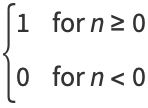 |
(56) |
 |
 |
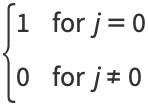 |
(57) |
plus the recurrence relation
 |
(58) |
For general  and
and  , this is equivalent to
, this is equivalent to
 |
(59) |
and for  , it simplifies to
, it simplifies to
 |
(60) |
For  , the harmonic number can be written
, the harmonic number can be written
![c_n^((j))=(-1)^j|_n]!s(-n,j),](http://mathworld.wolfram.com/images/equations/HarmonicNumber/NumberedEquation28.gif) |
(61) |
where ![|_n]!](http://mathworld.wolfram.com/images/equations/HarmonicNumber/Inline164.gif) is the Roman factorial and
is the Roman factorial and  is a Stirling number of the first kind.
is a Stirling number of the first kind.
A separate type of number sometimes also called a "harmonic number" is a harmonic divisor number (or Ore number).
REFERENCES:
Bailey, D. H.; Borwein, J. M.; Calkin, N. J.; Girgensohn, R.; Luke, D. R.; and Moll, V. H. Experimental Mathematics in Action. Wellesley, MA: A K Peters, 2007.
Borwein, J. and Bailey, D. Mathematics by Experiment: Plausible Reasoning in the 21st Century. Wellesley, MA: A K Peters, 2003.
Borwein, D. and Borwein, J. M. "On an Intriguing Integral and Some Series Related to  ." Proc. Amer. Math. Soc. 123, 1191-1198, 1995.
." Proc. Amer. Math. Soc. 123, 1191-1198, 1995.
Coffman, S. W. "Problem 1240 and Solution: An Infinite Series with Harmonic Numbers." Math. Mag. 60, pp. 118-119, 1987.
Conway, J. H. and Guy, R. K. The Book of Numbers. New York: Springer-Verlag, pp. 143 and 258-259, 1996.
de Doelder, P. J. "On Some Series Containing  and
and  for Certain Values of
for Certain Values of  and
and  ." J. Comp. Appl. Math. 37, 125-141, 1991.
." J. Comp. Appl. Math. 37, 125-141, 1991.
DeTemple, D. W. "The Non-Integer Property of Sums of Reciprocals of Consecutive Integers." Math. Gaz. 75, 193-194, 1991.
Flajolet, P. and Salvy, B. "Euler Sums and Contour Integral Representation." Experim. Math. 7, 15-35, 1998.
Graham, R. L.; Knuth, D. E.; and Patashnik, O. "Harmonic Numbers" and "Harmonic Summation." §6.3 and 6.4 in Concrete Mathematics: A Foundation for Computer Science, 2nd ed. Reading, MA: Addison-Wesley, pp. 272-282, 1994.
Gosper, R. W. "harmonic Summation and exponential gfs." math-fun@cs.arizona.edu posting, Aug. 2, 1996.
Havil, J. Gamma: Exploring Euler's Constant. Princeton, NJ: Princeton University Press, 2003.
Hoffman, P. The Man Who Loved Only Numbers: The Story of Paul Erdős and the Search for Mathematical Truth. New York: Hyperion, 1998.
Huvent, G. "Autour de la primitive de  ." Feb. 3, 2002. http://perso.orange.fr/gery.huvent/articlespdf/Autour_primitive.pdf.
." Feb. 3, 2002. http://perso.orange.fr/gery.huvent/articlespdf/Autour_primitive.pdf.
Roman, S. "The Logarithmic Binomial Formula." Amer. Math. Monthly 99, 641-648, 1992.
Roman, S. The Umbral Calculus. New York: Academic Press, p. 99, 1984.
Savio, D. Y.; Lamagna, E. A.; and Liu, S.-M. "Summation of Harmonic Numbers." In Computers and Mathematics (Ed. E. Kaltofen and S. M. Watt). New York: Springer-Verlag, pp. 12-20, 1989.
Sloane, N. J. A. Sequences A001008/M2885, A002285/M3210, A002805/M1589, A004080, A006953/M2039, A056903, A082912, A089729, A091590, A096618, A114467, and A114468 in "The On-Line Encyclopedia of Integer Sequences."
Sondow, J. "Criteria for Irrationality of Euler's Constant." Proc. Amer. Math. Soc. 131, 3335-3344, 2003.
Sondow, J. "Problem 11026: An Identity Involving Harmonic Numbers." Amer. Math. Monthly 112, 367-369, 2005.
Trott, M. "The Mathematica Guidebooks Additional Material: Harmonic Numbers Inversion." http://www.mathematicaguidebooks.org/additions.shtml#S_3_06.
Young, R. M. "Euler's Constant." Math. Gaz. 75, 187-190, 1991.



|
|
|
|
التوتر والسرطان.. علماء يحذرون من "صلة خطيرة"
|
|
|
|
|
|
|
مرآة السيارة: مدى دقة عكسها للصورة الصحيحة
|
|
|
|
|
|
|
نحو شراكة وطنية متكاملة.. الأمين العام للعتبة الحسينية يبحث مع وكيل وزارة الخارجية آفاق التعاون المؤسسي
|
|
|